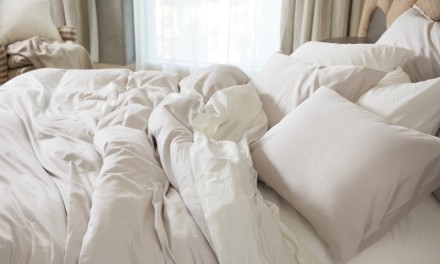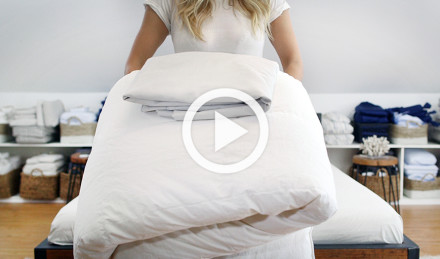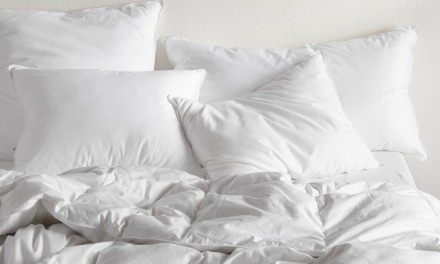When you imagine the perfect bedding, do you think of soft and ultra-smooth fabric with a mildly lustrous, high-end appearance? If so, sateen might be an ideal choice for you. But what is sateen exactly, and how does it compare to other textiles? Here's what you should know about this exceptional material.
What is sateen?
Sateen is a 100% cotton fabric with a satin weave. Made of long-staple Egyptian cotton, the material is luxuriously drapey and smooth yet soft and durable. Sateen bedding isn't overly shiny, but it does have a subtle sheen, which adds to its elegance. People appreciate sateen for its smooth, sumptuous feel and upscale aesthetic.
What is sateen?
Sateen is a 100% cotton fabric with a satin weave. Made of long-staple Egyptian cotton, the material is luxuriously drapey and smooth yet soft and durable. Sateen bedding isn't overly shiny, but it does have a subtle sheen, which adds to its elegance. People appreciate sateen for its smooth, sumptuous feel and upscale aesthetic.
How is sateen made?
Though sateen is a type of cotton, it's created using the distinct four-over-one-under weave traditionally used to make satin. And unlike satin, which is made with ultra-fine filament threads, the fabric is loomed from yarns. While the weave is looser than the standard square (one-over-one-under) weave, the thicker yarn size makes for a warm and cozy feel.
How is sateen made?
Though sateen is a type of cotton, it's created using the distinct four-over-one-under weave traditionally used to make satin. And unlike satin, which is made with ultra-fine filament threads, the fabric is loomed from yarns. While the weave is looser than the standard square (one-over-one-under) weave, the thicker yarn size makes for a warm and cozy feel.
What to Know About Sateen Bedding
There are many uses for sateen in the bedding world. You can get sateen sheets and pillowcases, plus a duvet cover and matching shams or mix and match with other fabrics. Parachute's premium sateen bedding sets and separates last for years, resist pilling and only get better with time.
The naturally warm material is undeniably snuggly, making it a great choice for people who run cold at night or want a cozier option for the winter. That said, sateen bedding isn't overly warm or cool, so it's great for year-round use too.
What to Know About Sateen Bedding
There are many uses for sateen in the bedding world. You can get sateen sheets and pillowcases, plus a duvet cover and matching shams or mix and match with other fabrics. Parachute's premium sateen bedding sets and separates last for years, resist pilling and only get better with time.
The naturally warm material is undeniably snuggly, making it a great choice for people who run cold at night or want a cozier option for the winter. That said, sateen bedding isn't overly warm or cool, so it's great for year-round use too.
How does sateen compare to other bedding fabrics?
If you like smooth-as-butter bedding but want something durable and warm, sateen might be the way to go. The material is a little heavier than other fabrics, making it less prone to wrinkles while adding to its cozy, inviting feel.
Having said that, there's nothing wrong with weighing your options. So, which is better, percale or sateen? And what about Egyptian cotton and satin? Find details below.
How does sateen compare to other bedding fabrics?
If you like smooth-as-butter bedding but want something durable and warm, sateen might be the way to go. The material is a little heavier than other fabrics, making it less prone to wrinkles while adding to its cozy, inviting feel.
Having said that, there's nothing wrong with weighing your options. So, which is better, percale or sateen? And what about Egyptian cotton and satin? Find details below.
Sateen vs. Egyptian Cotton
Ultra-fine and naturally soft long-staple cotton fibers are sourced from the Gossypium barbadense plant. While the material typically comes from Egypt, it can be harvested all over the world. However, bedding has to be made of certified long-staple cotton from Egypt to carry the Egyptian cotton label.
Sateen refers to a weave, and Egyptian cotton refers to the raw material used to create a fabric. This means bedding can be both — as with the Egyptian cotton sateen duvet covers and sheets you'll find from Parachute.
Sateen vs. Egyptian Cotton
Ultra-fine and naturally soft long-staple cotton fibers are sourced from the Gossypium barbadense plant. While the material typically comes from Egypt, it can be harvested all over the world. However, bedding has to be made of certified long-staple cotton from Egypt to carry the Egyptian cotton label.
Sateen refers to a weave, and Egyptian cotton refers to the raw material used to create a fabric. This means bedding can be both — as with the Egyptian cotton sateen duvet covers and sheets you'll find from Parachute.
Percale vs. Sateen Sheets
What's the difference between sateen and percale? Parachute's percale and sateen sheets are both made of long-staple Egyptian cotton, but they have a slightly different look and feel. The satin weave gives sateen a slight luster, whereas percale's square weave offers a matte finish.
Percale vs. Sateen Sheets
What's the difference between sateen and percale? Parachute's percale and sateen sheets are both made of long-staple Egyptian cotton, but they have a slightly different look and feel. The satin weave gives sateen a slight luster, whereas percale's square weave offers a matte finish.
Both are undeniably soft and durable, and they get better with every wash, though sateen is slightly more wrinkle resistant. Also, sateen has a warm and cozy feel, and percale is more crisp and cool.
Generally speaking, sateen is better for those who get chilly at night, and percale is better for folks who run hot. That said, both fabrics are suitable for year-round use.
Sateen vs. Satin
What's the difference between sateen and satin? The fabrics are woven using the same four-over-one-under weave, which is why sateen adopts the drapey, silky-soft qualities of satin.
However, sateen is made of cotton, and satin is made of either silk or a synthetic material like polyester or nylon. And as mentioned above, sateen is woven from yarns, whereas satin is loomed from thinner threads. Though sateen has a subtle sheen, you won't get the glossy look of silk. It's also warmer and softer than satin.
Sateen vs. Satin
What's the difference between sateen and satin? The fabrics are woven using the same four-over-one-under weave, which is why sateen adopts the drapey, silky-soft qualities of satin.
However, sateen is made of cotton, and satin is made of either silk or a synthetic material like polyester or nylon. And as mentioned above, sateen is woven from yarns, whereas satin is loomed from thinner threads. Though sateen has a subtle sheen, you won't get the glossy look of silk. It's also warmer and softer than satin.
Where to Buy the Best Sateen Bedding
If you're partial to sumptuously smooth fabrics but don't want anything too shiny, sateen is an excellent choice. It's sturdy and warm yet breathable and aesthetically pleasing, plus it gets better every time you wash it. What's not to love?
With that said, you don't have to dress your bed in only one fabric. Whether you want brushed cotton sheets and a sateen duvet cover, sateen sheets and a percale duvet, just a sateen fitted sheet with a linen bed cover or any other combo, you can pick and choose from Parachute's premium offerings.
Still on the fence about which bedding fabric to choose? Order a fabric swatch or schedule a virtual consultation with a Parachute stylist.
Where to Buy the Best Sateen Bedding
If you're partial to sumptuously smooth fabrics but don't want anything too shiny, sateen is an excellent choice. It's sturdy and warm yet breathable and aesthetically pleasing, plus it gets better every time you wash it. What's not to love?
With that said, you don't have to dress your bed in only one fabric. Whether you want brushed cotton sheets and a sateen duvet cover, sateen sheets and a percale duvet, just a sateen fitted sheet with a linen bed cover or any other combo, you can pick and choose from Parachute's premium offerings.
Still on the fence about which bedding fabric to choose? Order a fabric swatch or schedule a virtual consultation with a Parachute stylist.





